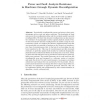208 search results - page 25 / 42 » Detecting Feature Interactions: How Many Components Do We Ne... |
OZCHI
2005
ACM
14 years 2 months ago
2005
ACM
Many software systems would significantly improve performance if they could interpret the nonverbal cues in their user’s interactions as humans normally do. Currently, Intellige...
FPLAY
2008
13 years 10 months ago
2008
Based on research that studied the challenges and difficulties faced by students taking games studies and game design courses, we propose that, while many students enrolled in gam...
FGR
2000
IEEE
14 years 26 days ago
2000
IEEE
Most eye trackers work well for open eyes. However, blinking is a physiological necessity for humans. Moreover, for applicationssuch as facial expression analysis and driver aware...
ICRA
2010
IEEE
13 years 7 months ago
2010
IEEE
— This paper presents an oceanographic toolchain that can be used to generate multi-vehicle robotic surveys for large-scale dynamic features in the coastal ocean. Our science app...
CHES
2008
Springer
13 years 10 months ago
2008
Springer
Dynamically reconfigurable systems are known to have many advantages such as area and power reduction. The drawbacks of these systems are the reconfiguration delay and the overhead...

